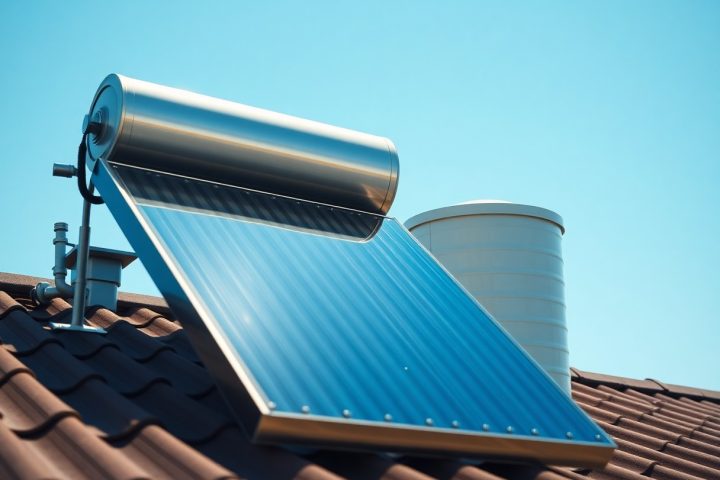Solar energy harnesses the power of the sun to provide efficient heating solutions for your water needs. By using solar collectors, this technology captures sunlight and converts it into heat, which is then transferred to your water supply. Understanding how solar water heating functions can help you make informed decisions about integrating this sustainable option into your home, ultimately reducing your energy bills and environmental footprint. In this blog post, you’ll discover the components, processes, and benefits of solar water heating systems, empowering you to leverage renewable energy in your daily life.
Overview of Solar Water Heating Systems
A solar water heating system collects and converts sunlight into thermal energy to heat water for residential or commercial use. These systems can significantly reduce your energy bills while providing a sustainable solution for hot water needs. By utilizing either active or passive techniques, you can harness the sun’s energy to efficiently warm water, enhancing your environmental responsibility and energy independence.
Active Solar Water Heating
Overview of active solar water heating systems reveals that they utilize mechanical components like pumps and controllers to circulate water and maximize heat collection. This method is highly effective in capturing solar energy, enabling you to achieve higher water temperatures compared to passive systems.
Passive Solar Water Heating
Around passive solar water heating systems, you will find that they rely on natural thermal dynamics without requiring electrical components. This approach is typically simpler and can be more cost-effective, allowing you to benefit from solar energy in a low-maintenance manner.
With passive solar water heating, the system operates based on the principles of natural circulation. Water is heated in solar collectors and then naturally rises to supply your demand without the need for pumps. This simplicity not only lowers installation and maintenance costs but also enhances reliability, making it an attractive option for many homeowners looking to adopt renewable energy solutions.
Key Components of Solar Water Heating
If you are considering solar water heating, understanding its key components is vital. These systems primarily consist of solar collectors, storage tanks, and piping, all working in tandem to efficiently harness and maintain solar energy for your hot water needs. Each component plays a significant role in ensuring optimal performance and energy efficiency, which can greatly benefit your household energy consumption.
Solar Collectors
Before entering into the workings of solar water heating, it’s important to understand solar collectors. These devices are responsible for capturing sunlight and converting it into heat. Typically mounted on rooftops, solar collectors use a series of tubes filled with water or a heat-transfer fluid, helping to efficiently absorb the sun’s energy throughout the day.
Storage Tanks
Along with solar collectors, storage tanks are integral to a solar water heating system. They store the heated water generated by the collectors, ensuring you have access to warm water even when the sun isn’t shining. These tanks can vary in size based on your household’s hot water demand and the capacity of your solar collector system.
Indeed, the storage tank plays a significant role in maintaining a steady supply of hot water for your household. It acts as a buffer, allowing you to draw hot water whenever needed, while also minimizing heat loss through adequate insulation. The size and type of storage tank you select can affect the overall efficiency of your solar water heating system, so it’s wise to consider your specific hot water needs before making a decision. Making the right choice will ensure that you enjoy reliable hot water while maximizing the benefits of your solar heating investment.
How Solar Water Heating Works
Even in cooler climates, solar water heating systems can efficiently harness sunlight to produce hot water for your home. By using solar collectors, these systems capture solar energy and transfer it to water, resulting in reduced energy bills and a smaller environmental footprint. This renewable approach not only provides you with hot water but also contributes to sustainable living by reducing reliance on fossil fuels.
Heat Transfer Mechanisms
Above the solar collector, sunlight strikes the surface, which absorbs the heat and warms up the fluid circulating through the system. This heat is then transferred to the water stored in the tank, enabling efficient heating even on cloudy days. Understanding these mechanisms highlights how effectively solar energy can be used in everyday applications.
System Operation
Transfer of heat from the collectors to the storage tank is a seamless process facilitated by a pump or thermosiphon system. Your solar water heating system operates by circulating a fluid through the collectors, where it is heated by sunlight. This heated fluid then transfers its warmth to the water stored in a tank, ensuring you always have hot water available when needed.
For instance, during sunny periods, the solar collectors become warm, creating a temperature differential that prompts the heat transfer fluid to flow into the storage tank. As the tank fills with heated water, you can enjoy hot showers or complete household tasks. Advanced controls may optimize this process, ensuring maximum efficiency and consistent performance regardless of weather conditions. This system allows you to harness solar energy effectively, providing a reliable source of hot water while minimizing your energy costs.
Installation Considerations
All solar water heating systems require careful planning and installation to function effectively. Factors such as climate, roof orientation, and available space significantly influence their performance. You should evaluate your property and local conditions to ensure an optimal setup for your system, maximizing efficiency while minimizing costs.
Site Assessment
Above all else, a thorough site assessment is crucial for determining the viability of a solar water heating system. You must consider the amount of sunlight your location receives throughout the year, as well as any obstructions such as trees or buildings that may cast shade on your solar collectors.
Regulatory Requirements
Beside assessing your site, you should be aware of any regulatory requirements that may apply to the installation of solar water heating systems. Different municipalities might have specific building codes, permits, or incentives that can affect your project.
And addressing these regulatory requirements is fundamental to a successful installation. You may need to consult with local authorities to determine what permits are needed, whether inspections are required, and how to comply with safety standards. Additionally, some regions offer incentives or rebates for solar installations, which can reduce your overall costs. By understanding these regulations upfront, you can streamline your installation process and avoid potential delays or complications later on.
Benefits of Solar Water Heating
Not only does solar water heating reduce your energy bills, but it also increases your home’s value. By harnessing the power of the sun, you can significantly cut down on your reliance on traditional energy sources, leading to long-term savings. Additionally, many solar water heating systems are eligible for government incentives, making the initial investment more appealing. You’ll appreciate both the economic and environmental benefits that come from switching to this renewable energy source.
Energy Efficiency
About 70% of water heating energy consumption can be offset by using solar water heating systems. This not only leads to a noticeable decrease in utility costs but also enhances the overall energy efficiency of your home. By installing solar water heating, you can maximize the amount of solar energy used for everyday water heating needs, allowing you to save money while enjoying reliable hot water throughout the year.
Environmental Impact
Across the globe, solar water heating systems contribute to the reduction of greenhouse gas emissions. By utilizing solar energy, you are minimizing your carbon footprint and promoting renewable energy. This shift away from fossil fuels not only helps combat climate change but also fosters a more sustainable future for generations to come.
With the adoption of solar water heating, your household can play a vital role in reducing air pollutants caused by traditional energy sources. This helps promote cleaner air and healthier living conditions in your community. Furthermore, as more individuals choose solar energy, collective demand for fossil fuels decreases, encouraging the development of renewable resources and reinforcing the transition toward a more sustainable energy economy.
Maintenance and Longevity
To ensure the efficiency and durability of your solar water heating system, regular maintenance is vital. This not only extends the lifespan of your system but also ensures optimal performance throughout its service life. By addressing maintenance needs promptly, you can avoid costly repairs and enjoy the benefits of your investment for years to come.
Routine Maintenance
Among the key aspects of routine maintenance are inspecting the system for any leaks, checking the fluid levels, and ensuring that the panels are free of debris. Regularly flushing the system can also enhance efficiency by preventing sediment buildup. Scheduling professional maintenance at least once a year can help to identify any potential issues early on.
Common Issues and Solutions
Around your solar water heating system, you may encounter common issues such as insufficient hot water production and leaks. Fortunately, many of these problems have straightforward solutions, such as adjusting the temperature settings or repairing or replacing damaged components to keep your system running efficiently.
Considering the various challenges that can arise with solar water heating systems, it’s important to stay informed about potential solutions. For instance, if you experience a significant drop in hot water supply, check the thermostat settings or inspect the solar collectors for shading or debris. In the case of leaks, identify the source and determine whether a sealant can suffice or if a professional’s help is required. Proactive troubleshooting can save you time and money while enhancing the longevity of your system.
To wrap up
Hence, understanding how solar water heating works empowers you to make informed decisions about adopting this efficient technology. By harnessing sunlight through collectors and transferring that energy to your water supply, you can significantly reduce your energy costs and environmental impact. Whether you’re looking to heat your home or provide hot water for daily use, solar water heating systems offer a sustainable solution that benefits both your wallet and the planet.




